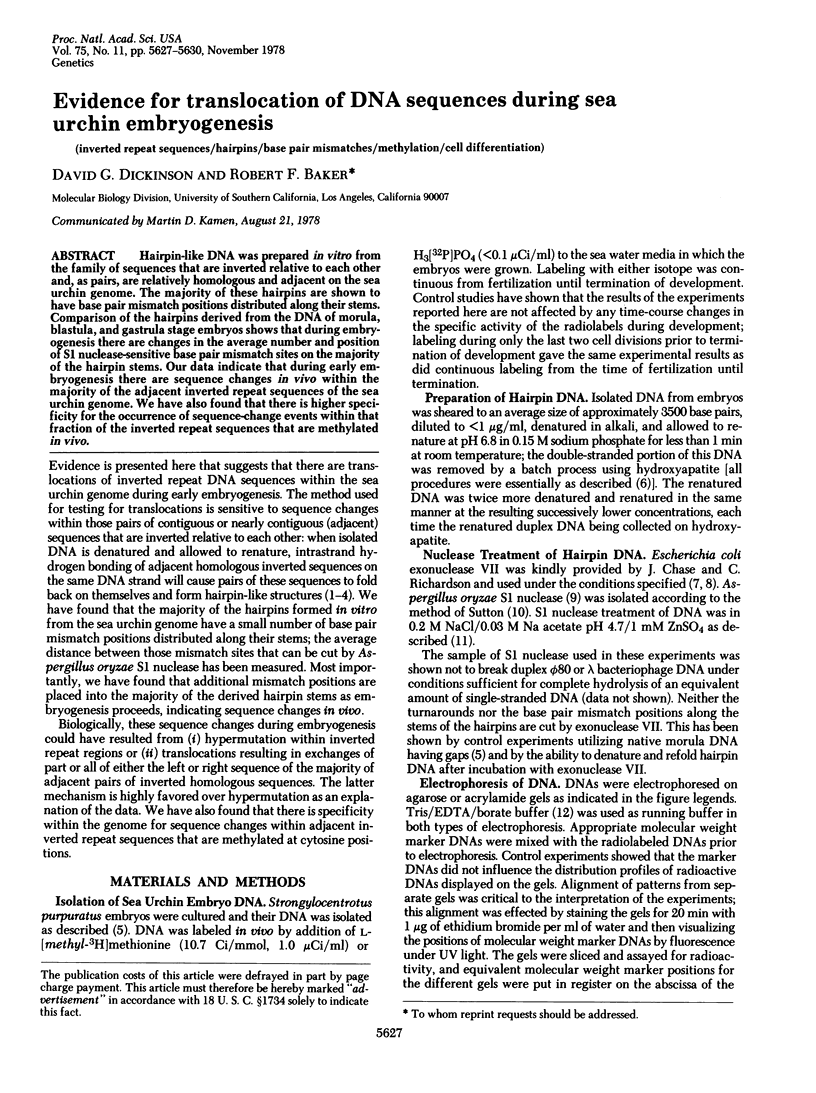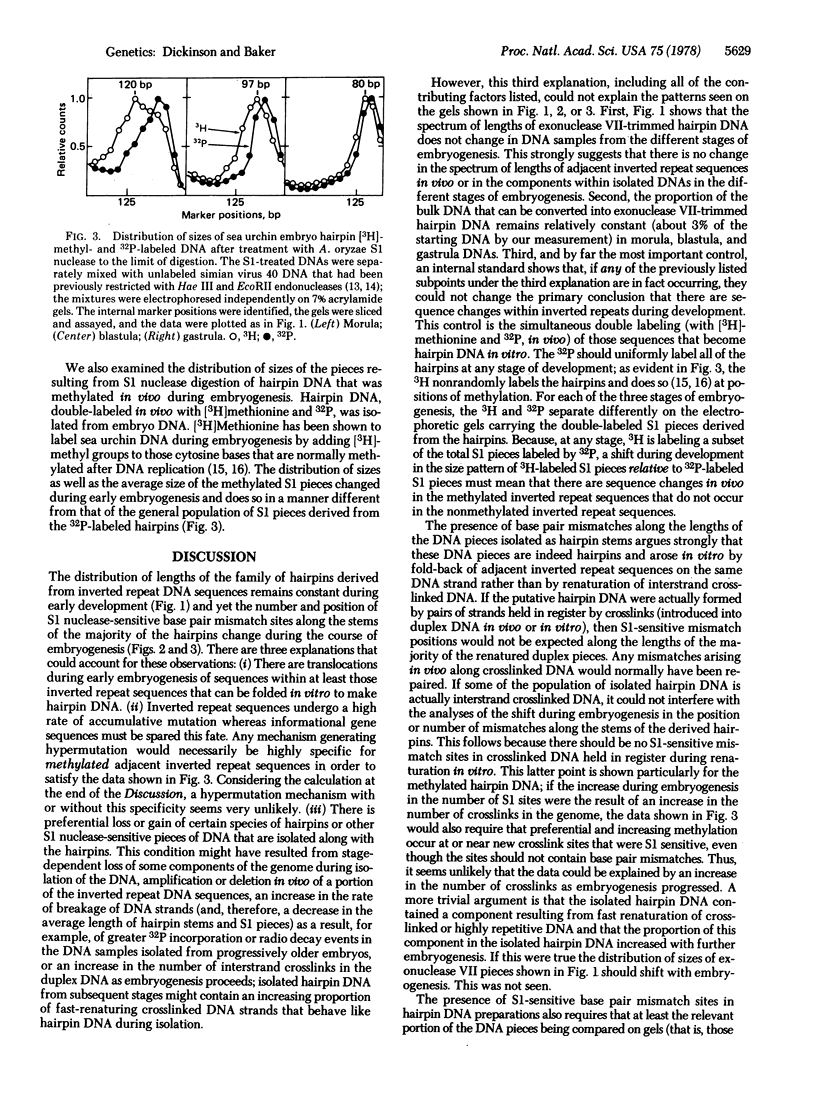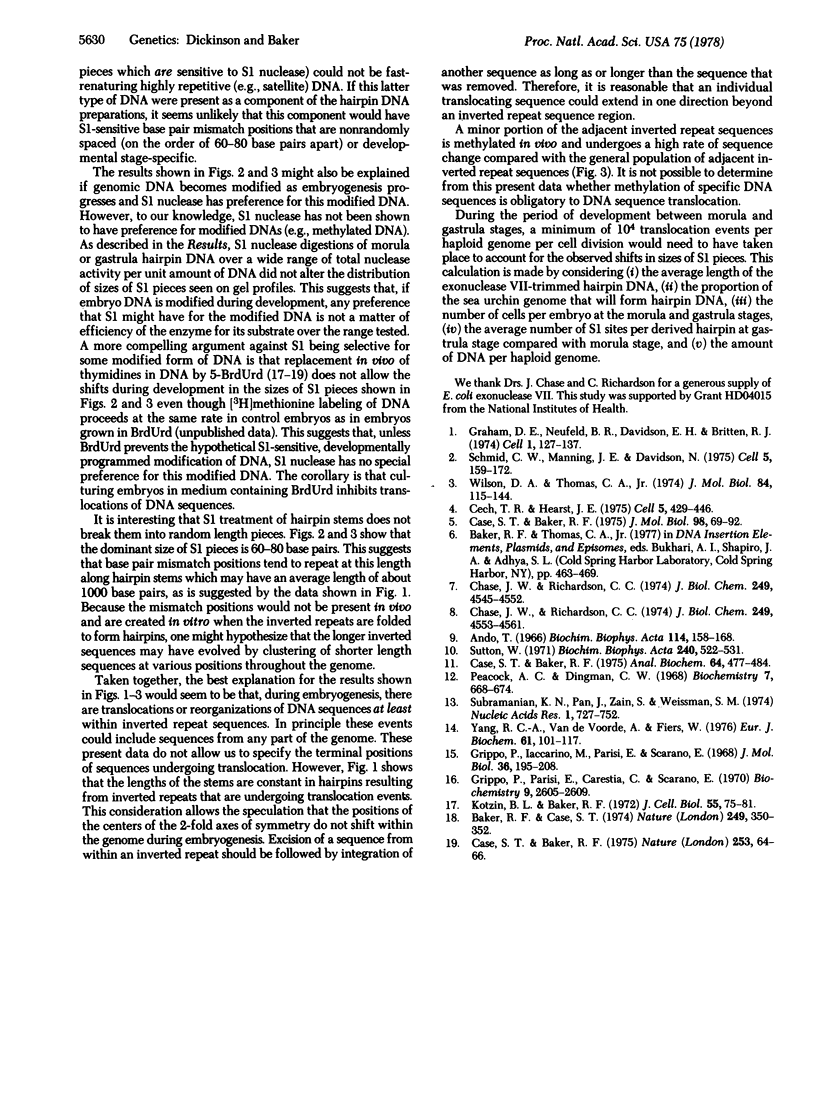Abstract
Hairpin-like DNA was prepared in vitro from the family of sequences that are inverted relative to each other and, as pairs, are relatively homologous and adjacent on the sea urchin genome. The majority of these hairpins are shown to have base pair mismatch positions distributed along their stems. Comparison of the hairpins derived from the DNA of morula, blastula, and gastrula stage embryos shows that during embryogenesis there are changes in the average number and position of S1 nuclease-sensitive base pair mismatch sites on the majority of the hairpin stems. Our data indicate that during early embryogenesis there are sequence changes in vivo within the majority of the adjacent inverted repeat sequences of the sea urchin genome. We have also found that there is higher specificity for the occurrence of sequence-change events within that fraction of the inverted repeat sequences that are methylated in vivo.
Full text
PDF



Selected References
These references are in PubMed. This may not be the complete list of references from this article.
- Ando T. A nuclease specific for heat-denatured DNA in isolated from a product of Aspergillus oryzae. Biochim Biophys Acta. 1966 Jan 18;114(1):158–168. doi: 10.1016/0005-2787(66)90263-2. [DOI] [PubMed] [Google Scholar]
- Baker R. F., Case S. T. Effect of 5-bromodeoxyuridine on the size distribution of DNAs isolated from sea urchin embryos. Nature. 1974 May 24;249(455):350–352. doi: 10.1038/249350b0. [DOI] [PubMed] [Google Scholar]
- Case S. T., Baker R. F. Investigation into the use of Aspergillus oryzae S1 nuclease in the presence of solvents which destabilize or prevent DNA secondary structure: formaldehyde, formamide, and glyoxal. Anal Biochem. 1975 Apr;64(2):477–484. doi: 10.1016/0003-2697(75)90457-1. [DOI] [PubMed] [Google Scholar]
- Case S. T., Baker R. F. Position of regularly spaced single-stranded regions relative to 5-bromodeoxyuridine-sensitive sites in sea urchin morula DNA. Nature. 1975 Jan 3;253(5486):64–66. doi: 10.1038/253064a0. [DOI] [PubMed] [Google Scholar]
- Case S. T., Baker R. G. Detection of long eukaryote-specific pyrimidine runs in repetitive DNA sequences and their relation to single-stranded regions in DNA isolated from sea urchin embryos. J Mol Biol. 1975 Oct 15;98(1):69–92. doi: 10.1016/s0022-2836(75)80102-1. [DOI] [PubMed] [Google Scholar]
- Cech T. R., Hearst J. E. An electron microscopic study of mouse foldback DNA. Cell. 1975 Aug;5(4):429–446. doi: 10.1016/0092-8674(75)90062-8. [DOI] [PubMed] [Google Scholar]
- Chase J. W., Richardson C. C. Exonuclease VII of Escherichia coli. Mechanism of action. J Biol Chem. 1974 Jul 25;249(14):4553–4561. [PubMed] [Google Scholar]
- Chase J. W., Richardson C. C. Exonuclease VII of Escherichia coli. Purification and properties. J Biol Chem. 1974 Jul 25;249(14):4545–4552. [PubMed] [Google Scholar]
- Grippo P., Iaccarino M., Parisi E., Scarano E. Methylation of DNA in developing sea urchin embryos. J Mol Biol. 1968 Sep 14;36(2):195–208. doi: 10.1016/0022-2836(68)90375-6. [DOI] [PubMed] [Google Scholar]
- Grippo P., Parisi E., Carestia C., Scarano E. A novel origin of some deoxyribonucleic acid thymine and its nonrandom distribution. Biochemistry. 1970 Jun 23;9(13):2605–2609. doi: 10.1021/bi00815a007. [DOI] [PubMed] [Google Scholar]
- Kotzin B. L., Baker R. F. Selective inhibition of genetic transcription in sea urchin embryos. Incorporation of 5-bromodeoxyuridine into low molecular weight nuclear DNA. J Cell Biol. 1972 Oct;55(1):74–81. doi: 10.1083/jcb.55.1.74. [DOI] [PMC free article] [PubMed] [Google Scholar]
- Peacock A. C., Dingman C. W. Molecular weight estimation and separation of ribonucleic acid by electrophoresis in agarose-acrylamide composite gels. Biochemistry. 1968 Feb;7(2):668–674. doi: 10.1021/bi00842a023. [DOI] [PubMed] [Google Scholar]
- Schmid C. W., Manning J. E., Davidson N. Inverted repeat sequences in the Drosophila genome. Cell. 1975 Jun;5(2):159–172. doi: 10.1016/0092-8674(75)90024-0. [DOI] [PubMed] [Google Scholar]
- Subramanian K. N., Pan J., Zain S., Weissman S. M. The mapping and ordering of fragments of SV40 DNA produced by restriction endonucleases. Nucleic Acids Res. 1974 Jun;1(6):727–752. doi: 10.1093/nar/1.6.727. [DOI] [PMC free article] [PubMed] [Google Scholar]
- Sutton W. D. A crude nuclease preparation suitable for use in DNA reassociation experiments. Biochim Biophys Acta. 1971 Jul 29;240(4):522–531. doi: 10.1016/0005-2787(71)90709-x. [DOI] [PubMed] [Google Scholar]
- Wilson D. A., Thomas C. A., Jr Palindromes in chromosomes. J Mol Biol. 1974 Mar 25;84(1):115–138. doi: 10.1016/0022-2836(74)90216-2. [DOI] [PubMed] [Google Scholar]
- Yang R. C., Van de Voorde A., Fiers W. Cleavage map of the simian-virus-40 genome by the restriction endonuclease III of Haemopholus aegyptius. Eur J Biochem. 1976 Jan 2;61(1):101–117. doi: 10.1111/j.1432-1033.1976.tb10002.x. [DOI] [PubMed] [Google Scholar]


